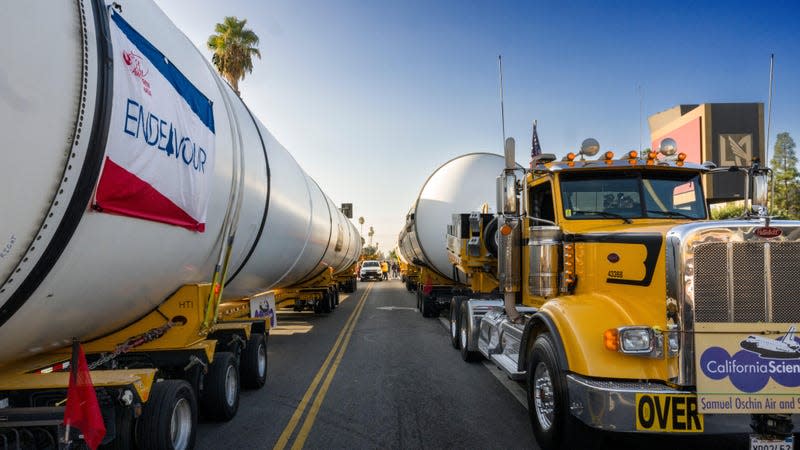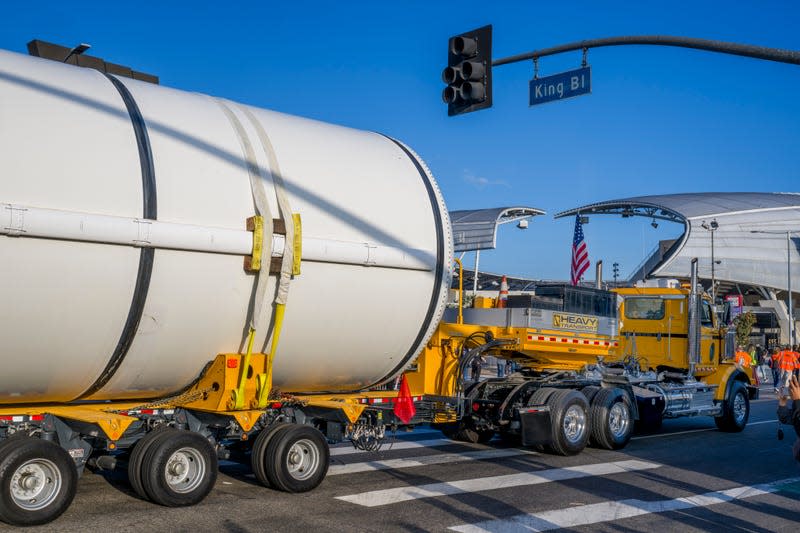Vintage Space Shuttle Boosters Take Over Los Angeles Streets in Rare Trek

The space shuttle components arrive at Los Angeles on October 11, 2023.
Twin rocket boosters of the retired Space Shuttle have made the trek to Los Angeles, where they will be stacked in a launch-ready, vertical position for the first time in over a decade.
On Wednesday, the components of the Space Shuttle were transported from the Mojave Air and Space Port on board two massive trucks for the last leg of their journey to the California Science Center.
Read more
Dragon Ball Daima Is The Newest DBZ Series And Toriyama Is Back
Tommy Tuberville Falling Off A Plane Is The Best Thing We've Seen Since The Cop Slide
There's a new South Park "event" teaser and god, we're already so tired
Only John Carpenter knows who’s the Thing at the end of The Thing
“Exactly eleven years after Endeavour’s memorable crosstown journey, we’re delighted that the public has once again demonstrated such enthusiasm for this historic arrival,” Jeffrey Rudolph, President and CEO of the California Science Center, said in a statement. “The arrival of our [SRBs] propels us one step closer to the completion of the future Samuel Oschin Air and Space Center, which will serve as a launchpad for creativity and innovation and will inspire future generations of scientists, engineers, and explorers.”
Now, the California Science Center will begin a six month process labeled as “Go for Stack,” putting together the Endeavor orbiter, the two side boosters, as well as the Space Shuttle’s external tank, to create its final, vertical display. This will be the first time the vehicle is stacked vertically outside of a NASA facility, and it will be no easy feat.

Together, the two side boosters provided 5.3 million pounds of thrust at liftoff.
The first part of the process involves installing the rocket’s aft skirts—a pair of skirt-shaped bottom segments that form the base of the solid rocket boosters. The solid rocket motors will be stacked on top of the aft skirts to form the solid rocket boosters. The Shuttle’s external tank, ET-94, will then be lifted into place, followed by the Endeavor orbiter, which will be lifted by a large crane and connected to the rest of the rocket stack.
The 15-story high reusable rocket motors served NASA’s Space Shuttle program, which ran from 1981 until 2011, producing more than 5 million pounds of thrust at liftoff, according to NASA. After burnout, the twin boosters descended back into the ocean, where they were recovered. Subsequently, they were refurbished and reused for the next launch.
For more spaceflight in your life, follow us on X (formerly Twitter) and bookmark Gizmodo’s dedicated Spaceflight page.
More from Gizmodo
Michigan TV network fires sports director for Mel Tucker ‘analysis’ that read more like PR work
Woman Arrested After Wrapping Car To Look Like A Florida State Trooper
Taylor Swift: The Eras Tour review: A love letter to fans (Taylor’s version)
Sorry, What?! Florida Man Walks Free After Stabbing His Date, But It Gets Worse
Sign up for Gizmodo's Newsletter. For the latest news, Facebook, Twitter and Instagram.

